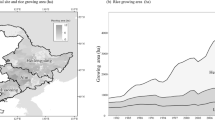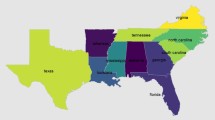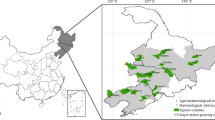Abstract
Extreme high temperatures may drastically reduce crop yield, especially when occurring during critical growth stages. The risk of future high temperatures may increase under global warming, this raises concerns regarding crop production. China is one of the most important corn production and consumer countries. The main summer corn cultivation region in China was taken as a sample to study the effects of extreme temperature on corn yield at present and in the near future (2021–2050). The determination of extreme high temperature threshold for corn is critical for assessment result. Based on historical observation data, we built a nonlinear regression model between temperature and corn yield, the extreme high temperature threshold of corn was determined as 36.06 °C in the study area. Multi-year average extreme high temperature days of the entire region during 1986–2015 were 5.2 days, the highest values appearing in the Midwestern area. The multi-year average extreme high temperature days increased every additional day could resulted in a 226.62 kg/ha multi-year average corn yield reducing. And over half of the stations, corn yield fluctuations had significant correlations with the number of extreme high temperature days (Nehtd). Nehtd displayed an increasing trend and reached 7.4 days and 11.6 days during 2021–2050 under RCP4.5 and RCP8.5, which could result in corn yield decreased by 9.2% and 27.3%, respectively.








Similar content being viewed by others

References
AghaKouchak, A., Cheng, L., Mazdiyasni, O., & Farahmand, A. (2014). Global warming and changes in risk of concurrent climate extremes: Insights from the 2014 California drought. Geophysical Research Letters,41, 8847–8852.
Ahmadalipour, A., Moradkhani, H., & Svoboda, M. (2017). Centennial drought outlook over the CONUS using NASA-NEX downscaled climate ensemble. International Journal of Climatology,37, 2477–2491.
Asseng, S., Ewert, F., & Martre, P. (2015). Rising temperatures reduce global wheat production. Nature Climate Change,5, 143–147.
Bao, Y., & Wen, X. (2017). Projection of China’s near- and long-term climate in a new high-resolution daily downscaled dataset NEX-GDDP. Journal of Meteorological Research,31, 236.
Butler, E. E., & Huybers, P. (2013). Adaptation of US maize to temperature variations. Nature Climate Change,3, 68–72.
Deryng, D., Conway, D., Ramankutty, N., et al. (2014). Global crop yield response to extreme heat stress under multiple climate change futures. Environmental Research Letters,9, 034011.
Ding, T., Qian, W., & Yan, Z. (2010). Changes in hot days and heat waves in China during 1961–2007. International Journal of Climatology,30(10), 1452–1462.
Easterling WE et al. 2007. Food, fibre and forest products Climate Change 2007: Impacts, Adaptation and Vulnerability. Contribution of Working Group II to the Fourth Assessment Report of the Intergovernmental Panel on Climate Change, ML.
FAO. 2017. http://www.fao.org/statistics/databases/. Accessed 2 Apr 2018.
Gao F. 2012. Simulation of Temperature by Decadal Prediction Experiments with BCC_CSM1.1, National Climate Center, China Meteorological Administration, Beijing, China (in Chinese).
Gornall, J., Betts, R., Burke, E., et al. (2010). Implications of climate change for agricultural productivity in the early twenty-first century. Philosophical Transactions of the Royal Society B,365, 2973–2989.
Gourdji, S. M., Sibley, A. M., & Lobell, D. B. (2013). Global crop exposure to critical high temperatures in the reproductive period: historical trends and future projections. Environmental Research Letters,8, 024041.
Hatfield, J. L., Boote, K. J., Kimball, B. A., et al. (2011). Climate Impacts on Agriculture: Implications for Crop Production. Agronomy Journal,103, 351–370.
Jiang, H. F., Wen, D. Y., & Li, N. (2010). A new simulation method for the diurnal variation of temperature-sub-sine simulation. Meteorology and Disaster Reduction Research,33(3), 61–65. (in Chinese).
Liu, S. X., Mo, X. G., Lin, Z. H., Xu, Y. Q., Ji, J. J., Wen, G., et al. (2010). Crop yield responses to climate change in the Huang-Huai-Hai Plain of China. Agricultural Water Management,97(8), 1195–1209.
Lobell, D. B., & Burke, M. B. (Eds.). (2009). Climate Change and Food Security: Adapting Agriculture to a Warmer World. Berlin: Springer.
Lobell, D. B., & Burke, M. B. (2010). On the use of statistical models to predict crop yield responses to climate change. Agricultural and Forest Meteorology,150, 1443–1452.
Lobell, D. B., Hammer, G. L., Chenu, K., Zheng, B., et al. (2015). The shifting influence of drought and heat stress for crops in northeast Australia. Global Change Biology,21, 4115–4127.
Lobell, D. B., Hammer, G. L., Mclean, G., et al. (2013). The critical role of extreme heat for maize production in the United States. Nature Climate Change,3, 497–501.
Luo, Q. (2011). Temperature thresholds and crop production: a review. Climate Change,109, 583–598.
Ritchie, J. T., NeSmith, D. S. (1991). Temperature and crop development, in Hanks, J., Ritchie, J.T., (Eds.), Modeling Plant and Soil Systems, Agronomy 31 (pp. 5–29). Madison: American Society of Agronomy.
Schlenker, W., Hanemann, W. M., & Fisher, A. C. (2006). The impact of global warming on U.S. agriculture: an econometric analysis of optimal growing conditions. Review of Economics and Statistics,88, 113–125.
Schlenker, W., & Roberts, M. J. (2009). Nonlinear temperature effects indicate severe damages to U.S. crop yields under climate change. Proceedings of the National Academy of Sciences,106(37), 15594–15598.
Siebert, S., & Ewert, F. (2014). Future crop production threatened by extreme heat. Environmental Research Letters,9, 041001.
Sun, Y., Zhang, X., Zwiers, F. W., et al. (2014). Rapid increase in the risk of extreme summer heat in Eastern China. Nature Climate Change,4(12), 1082–1085.
Teixeira, E. I., Fischer, G., van Velthuizen, H., Walter, C., & Ewert, F. (2011). Global hot-spots of heat stress on agricultural crops due to climate change. Agricultural and Forest Meteorology,170, 206–215.
Thrasher, B., Maurer, E. P., McKellar, C., & Duffy, P. B. (2012). Technical note: bias correcting climate model simulated daily temperature extremes with quantile mapping. Hydrology and Earth System Sciences,16(9), 3309–3314.
Wang, L., Liao, S., Huang, S., Ming, B., Meng, Q., & Wang, P. (2018). Increasing concurrent drought and heat during the summer maize season in Huang–Huai–Hai Plain, China. International Journal of Climatology,38(7), 3177–3190.
Yu, M., Li, Q., Hayes, M. J., Svoboda, M. D., & Heim, R. R. (2014). Are droughts becoming more frequent or severe in China based on the standardized precipitation evapotranspiration index: 1951–2010. International Journal of Climatology,34(3), 545–558.
Zhang, Q., Zhang J. Q., Guo E. L., Yan D. H., & Sun Z. Y. (2015). The impacts of long-term and year-to-year temperature change on corn yield in China. Theoretical & Applied Climatology, 119(1–2), 77–82.
Acknowledgements
This study is supported by the National Natural Science Foundation of China under Grant Nos. 41501553, the Natural Science Foundation of Jiangsu under Grant No. BK20150898. The authors declare that there is no conflict of interest in the manuscript.
Author information
Authors and Affiliations
Corresponding author
Rights and permissions
About this article
Cite this article
Zhang, Q., Yang, Z. Impact of Extreme Heat on Corn Yield in Main Summer Corn Cultivating Area of China at Present and Under Future Climate Change. Int. J. Plant Prod. 13, 267–274 (2019). https://doi.org/10.1007/s42106-019-00052-w
Received:
Accepted:
Published:
Issue Date:
DOI: https://doi.org/10.1007/s42106-019-00052-w



